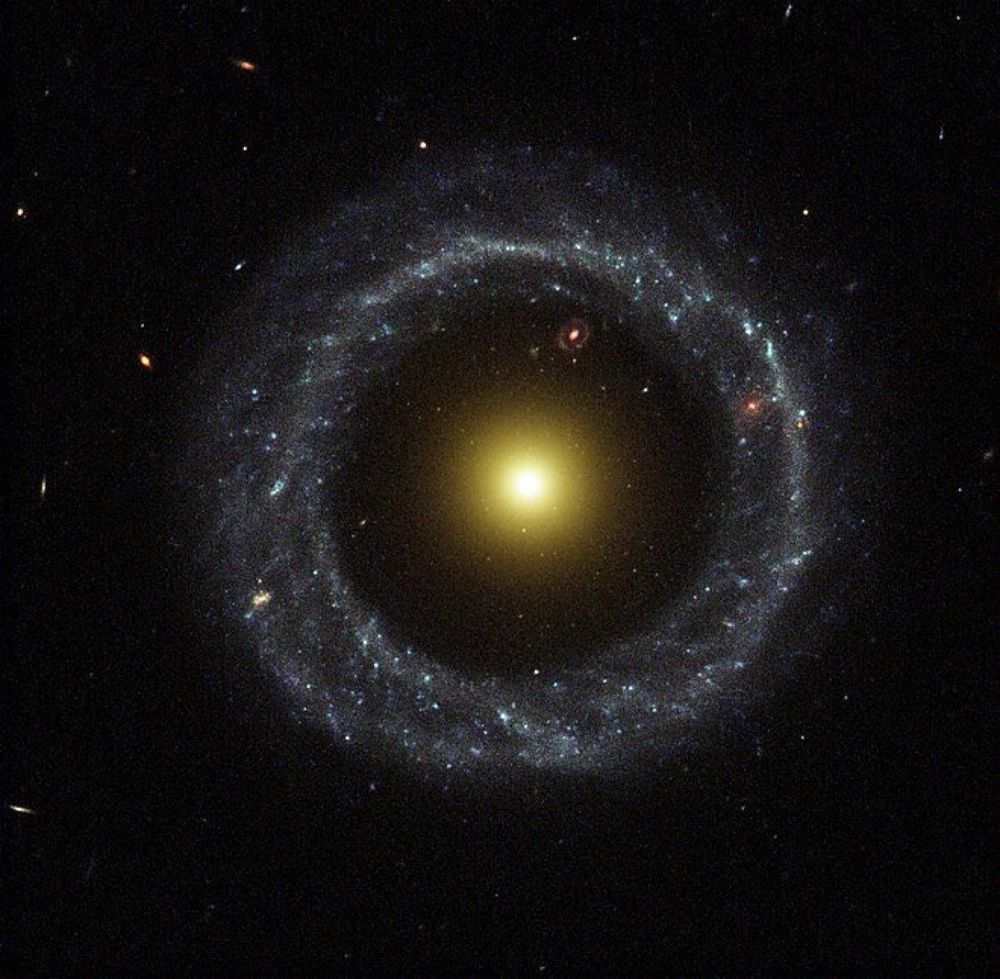

A nearly perfect circle full of young blue stars surrounds a spheroid of mostly older red giant stars. In between is a gap that appears almost completely empty.
Delightfully distinctive.
📸 Credit: NASA/STScl/AURA

At 66 billion solar masses, it’s nearly as massive as the entire Milky Way galaxy.
An unimaginably monstrous beast, prowling around the cosmos.
#BlackHole ⚫️

At 66 billion solar masses, it’s nearly as massive as the entire Milky Way galaxy.
An unimaginably monstrous beast, prowling around the cosmos.
#BlackHole ⚫️
A wormhole is a hypothetical structure connecting two different points in spacetime. This theoretical passageway creates a shortcut through the cosmos; a tunnel through the fabric of the Universe.

A wormhole is a hypothetical structure connecting two different points in spacetime. This theoretical passageway creates a shortcut through the cosmos; a tunnel through the fabric of the Universe.
Sedna takes around 11,400 years to orbit the Sun. This is the longest orbital period of any known object in the solar system that is its size or larger.

Sedna takes around 11,400 years to orbit the Sun. This is the longest orbital period of any known object in the solar system that is its size or larger.
This spectacular collection of stars contains some of the most massive types of stars known across the Universe, including many menacing supergiants.
NASA

This spectacular collection of stars contains some of the most massive types of stars known across the Universe, including many menacing supergiants.
NASA

Pluto is orbited by five moons: Charon, Hydra, Kerberos, Nix and Styx.

Pluto is orbited by five moons: Charon, Hydra, Kerberos, Nix and Styx.
📸 Credit: NASA/ESA/Zolt G. Levay (STScI)

📸 Credit: NASA/ESA/Zolt G. Levay (STScI)
Overall, the Universe displays remarkable patterns. It’s as if nature employs a fractal design, echoing similar structures from the cosmos to the quantum.
📸 Credits: NOAA/NASA/ESA/CIRA

Overall, the Universe displays remarkable patterns. It’s as if nature employs a fractal design, echoing similar structures from the cosmos to the quantum.
📸 Credits: NOAA/NASA/ESA/CIRA
The Boomerang Nebula is the coldest known object in the Universe.
This frigid nebula has an average temperature of around -458 °F! 🥶
📸 Credit: ESA/NASA

The Boomerang Nebula is the coldest known object in the Universe.
This frigid nebula has an average temperature of around -458 °F! 🥶
📸 Credit: ESA/NASA
My goal is to start making original video content on YouTube (I will also post here), as well as continue to provide daily factual space and science content.
Your support is much appreciated!
www.youtube.com/@FarLife2

My goal is to start making original video content on YouTube (I will also post here), as well as continue to provide daily factual space and science content.
Your support is much appreciated!
www.youtube.com/@FarLife2
~ FarLife
📸 Credit: NASA/ESA/CSA

~ FarLife
📸 Credit: NASA/ESA/CSA
Perhaps there are thousands of blanets orbiting around Sagittarius A* right now. A supermassive planetary system.

Perhaps there are thousands of blanets orbiting around Sagittarius A* right now. A supermassive planetary system.
This colossal star was once visible in our night sky, but due to its extreme “shedding” as it reaches the end of its stellar life, it has dimmed to the point that it can only be seen with telescopes.

This colossal star was once visible in our night sky, but due to its extreme “shedding” as it reaches the end of its stellar life, it has dimmed to the point that it can only be seen with telescopes.

A fast moving jet of particles produced by Vela was spotted by the Chandra X-Ray Observatory. The pulsar spans only 12 miles in diameter and rotates over 11 times per second, faster than a helicopter rotor.
A fast moving jet of particles produced by Vela was spotted by the Chandra X-Ray Observatory. The pulsar spans only 12 miles in diameter and rotates over 11 times per second, faster than a helicopter rotor.
This magnificent galaxy spans 100,000 light-years in diameter.
Messier 77 is notable for its intensely bright center surrounded by a fuzzy cloud of gas and dust.
NASA

This magnificent galaxy spans 100,000 light-years in diameter.
Messier 77 is notable for its intensely bright center surrounded by a fuzzy cloud of gas and dust.
NASA
NASA

NASA
In simple terms, it exists when three or more objects with similar mass, such as stars or planets, are in close proximity and therefore exerting force on each other.

In simple terms, it exists when three or more objects with similar mass, such as stars or planets, are in close proximity and therefore exerting force on each other.
Also known as Simeis 147, this striking nebula displays twisting filaments that take the shape of a plate of spaghetti. It also includes a powerful pulsar hidden within.
Magnificent! 🍝
📸 Credit: Georges Attard

Also known as Simeis 147, this striking nebula displays twisting filaments that take the shape of a plate of spaghetti. It also includes a powerful pulsar hidden within.
Magnificent! 🍝
📸 Credit: Georges Attard
Quasars are among the most luminous objects in the Universe. They can even outshine entire galaxies.
📸 Credit: NASA/ESA/J. Olmsted

Quasars are among the most luminous objects in the Universe. They can even outshine entire galaxies.
📸 Credit: NASA/ESA/J. Olmsted
At 66 billion solar masses, it’s nearly as massive as the entire Milky Way galaxy.
An unimaginably monstrous beast, prowling around the cosmos.

At 66 billion solar masses, it’s nearly as massive as the entire Milky Way galaxy.
An unimaginably monstrous beast, prowling around the cosmos.
1. Radio
2. Infrared
3. Visible
4. Ultraviolet
5. X-Rays
6. Gamma Rays

1. Radio
2. Infrared
3. Visible
4. Ultraviolet
5. X-Rays
6. Gamma Rays

